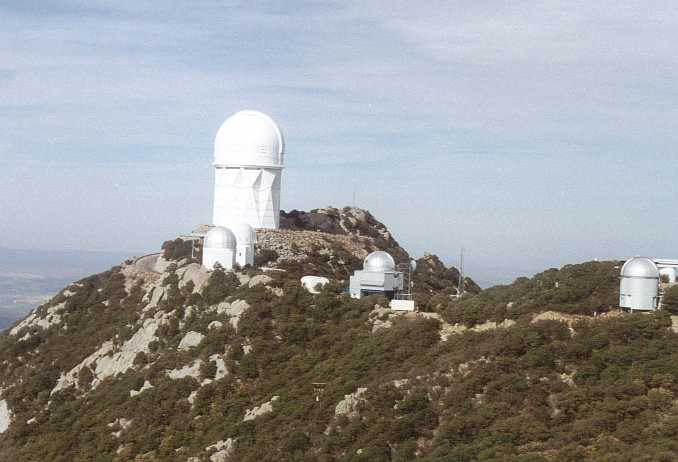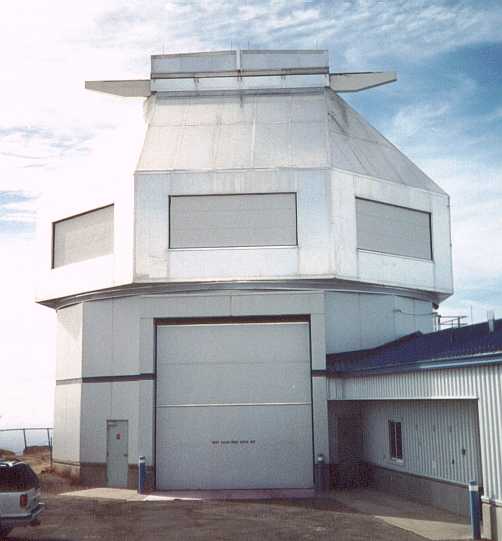
Probably the most famous US observatory is the huge complex at Kitt Peak National Observatory (part of the National Optical Astronomy Observatory network) outside of Tucson, Arizona. Institutions the world over, and a rich guy, have telescopes here. As a partly publicly funded facility, you can tour the grounds, and even reserve time on a 16" scope for public use. The summit is at 6875 feet.
Below is a
mosaic I took from the public viewing balcony in the 4-meter (158 inch) Nicholas
U. Mayall telescope dome that
shows most of the other scopes. Many scopes here, such as the big Mayall scope
completed in 1970,
date from the pre-alt-azimuth mounting days, and so have typical, classic
domes. In 1997, twenty-two vents were installed in the dome for improved
air circulation and temperature control. It is used primarily for infrared and
faint visible light observations such as determining the rotation curves of
distant galaxies and the dynamical structure of elliptical
galaxies such as M87 and M49.
The WIYN scope, in the far upper right background, is one of the newer
boxy, short focal length, large diameter types built today. The McMath-Pierce
solar scope (tilted triangle a far left), which, as discussed on the NSO page,
can have unique designs typical of solar observing. The structure includes
a tower nearly 100 feet in height surmounted by a 3-mirror heliostat that
collects light and directs it down the tunnel that slants two hundred feet to
the ground where the sun is viewed at the prime focus. Unlike other solar
telescopes, the McMath-Pierce, which normally studies sunspots and solar
spectra, is sensitive enough to observe bright stars at night!
There are many more smaller but specialized telescopic facilities here, including the Warner & Swasey Observatory Burrell Schmidt Telescope of my alma mater Case Western Reserve U. See http://www.noao.edu/outreach/kptour/map.html for tons more info.


Here's the 18-story Mayall scope dome (above), and part of the scope (below left, it's
largely blocked by the old-style equatorial mount). Because I'm lucky
enough to know two folks who work there, I got to tour the inside of the Mayall
and WIYN (below right) observatories! Most large scopes these days are compact
and boxy and barely fit inside their domes, so it's hard to photograph them as
you are invariably too close, as was the case with the 3.5-meter WIYN. By
comparison to the 4-meter Mayall, with a moving weight of 375 tons, the only
slightly smaller WIYN weighs only 46 tons. Gone too are
the days when the astronomer would be at the eyepiece or even in the
observatory, the quarters are so tight and the instruments so sensitive that his
or her body heat would ruin the observing, especially in the tight quarters of
the modern compact domes and adaptive optics. Note the large openings in
all sides of the comparatively tiny WIYN dome to facilitate equilibration of the inside and outside
air. All the electronics are kept in isolated, air-conditioned rooms.
With better thermal control and adaptive optics, the WIYN can outperform the
larger Mayall.

